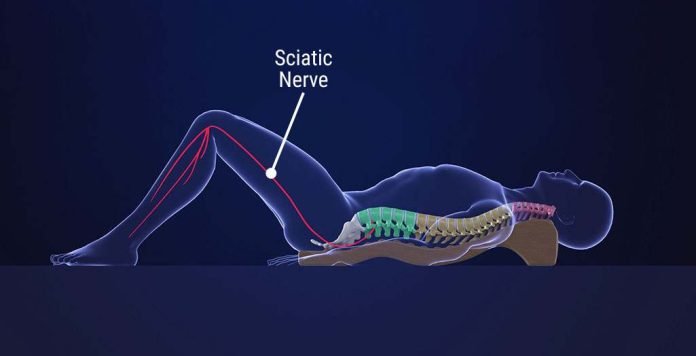Sciatica is a condition caused by compression of the sciatic nerve, resulting in pain that can range from mild to debilitating. It is estimated that up to 40% of people will experience some form of sciatica during their lifetime. While there are various treatments available to help reduce and manage symptoms, it is important to understand how long it takes for the sciatic nerve to heal completely. This article aims to provide an overview of what one should expect when recovering from such an injury, as well as highlighting some potential complications associated with prolonged healing times.
The recovery process following any kind of nerve damage or trauma can be complex and unpredictable. With regards to sciatica specifically, diagnosis and treatment depend on individual factors such as age, lifestyle habits, medical history and underlying conditions. In general terms however, complete resolution may take several months or longer depending on the severity of the initial injury and any further aggravation which occurs along the way.
Immediate relief can often be achieved through rest and/or physical therapy; this allows time for minor injuries to resolve naturally while providing symptom relief in cases where more severe damage has occurred. For many sciatica sufferers, medical intervention may become necessary if conservative measures fail to produce satisfactory results over time. Such interventions include injections, surgical decompression procedures or minimally invasive techniques designed to alleviate pressure on affected nerves.
What Is Sciatica?
Sciatica is a term used to describe pain that radiates along the sciatic nerve. This nerve originates in the lower back and travels through the buttocks, hips, and down each leg. It is caused by irritation or compression of one or more of the five sets of nerve roots in the lower spine. The most common symptom of sciatica is a sharp shooting pain felt on one side of the body from the lower back all the way down to the toes. In some cases, numbness or weakness may also be present in addition to pain.
The exact cause of sciatica can vary from person to person and depends on which nerves are being compressed or irritated. Some potential causes include herniated discs, bone spurs, pregnancy-related pelvic changes, spinal stenosis (narrowing between vertebrae), degenerative disc disease, injury to muscles or ligaments around your spine due to trauma such as falls or sports injuries, and even tight hamstring muscles. Treatment for sciatica typically involves conservative measures such as rest, stretching exercises, physical therapy, ice/heat packs, medications for inflammation and/or muscle relaxation, lifestyle modifications like avoiding activities that aggravate symptoms; however if these treatments fail to provide relief then surgery may be necessary.
Causes Of Sciatica Nerve Pain
It may seem ironic that something as small and seemingly insignificant as a nerve could cause so much pain, yet this is the case with sciatica. Although the exact cause of each individual’s sciatica pain can vary, here are some common causes:
• Herniated Discs – This occurs when one or more discs in the spine become weakened or ruptured, resulting in them bulging out from between vertebrae and pressing on nerves.
• Spinal Stenosis – This condition happens when there is an excessive narrowing of the spinal canal which compresses nerve roots and results in inflammation.
• Piriformis Syndrome – This syndrome occurs when tight muscles surrounding your hips compress the sciatic nerve, leading to intense pain radiating down through the buttocks and legs.
• Injury to Muscles/Ligaments – Trauma such as falls or sports injuries can lead to injury of muscles or ligaments around the spine, causing irritation of nearby nerves including those along the sciatic nerve pathway.
These are just a few examples of how sciatica can develop; however it’s important to note that not all cases have an identifiable underlying cause. In these situations, treatment should focus on managing symptoms rather than finding a specific source for pain relief. The best way to determine what might be causing your own particular type of sciatica is by speaking with a doctor or specialist who specializes in back pain management and diagnosis.
Treatments For Sciatica Nerve Pain
Treating sciatica nerve pain can often involve a combination of therapies depending on the severity and underlying cause. Here are some common treatment options that may be recommended to reduce symptoms and help patients return to their normal activities:
• Acupuncture Treatment – This ancient Chinese practice involves inserting thin needles into certain points along the body in order to stimulate energy flow, relieve tension, and promote healing. It is thought to provide relief by blocking pain signals from reaching the brain as well as releasing endorphins which naturally reduce discomfort.
• Physical Therapy – A physical therapist can develop an individualized program designed to strengthen weakened muscles around the spine, stretch tight ones, improve posture, increase flexibility, and manage stress levels. Exercises such as stretching or yoga may also be prescribed for at-home use between appointments.
• Nerve Block – Injections containing local anesthetics or steroids may be used to temporarily block nerves responsible for sending pain signals throughout the body. These injections can help diagnose what type of condition is causing your sciatica as well as providing short-term relief from uncomfortable sensations.
• Chiropractic Treatment – Spinal manipulation may also be beneficial in treating sciatica symptoms since it works to decrease pressure on affected nerves while promoting alignment of vertebrae in the lower back region. Regular visits with a chiropractor could potentially resolve chronic cases without need for more invasive treatments such as surgery.
• Pain Medication – Over-the-counter medications such as ibuprofen or acetaminophen may offer temporary symptom relief; however long term use should always be discussed with your doctor first due to potential side effects when taken regularly over time. Prescription strength opioids may also be prescribed if more intense relief is needed but these should only been used sparingly given their addictive qualities and other dangers associated with prolonged usage.
In many instances, combining different forms of treatment will yield greater results than focusing solely on one method alone; however each person’s unique situation should always be considered when designing a therapeutic plan so that maximum benefit can be achieved safely and effectively.
Recovery Time For Sciatica Nerve Pain
When it comes to sciatica nerve pain, the old adage “time heals all wounds” could certainly be applied. Depending on the severity of your condition and underlying cause, recovery time can range from a few weeks to several months or even longer. Fortunately, most cases will improve with appropriate treatment in a relatively short amount of time. Here are some tips that may help speed up healing:
• Rest – Taking breaks throughout the day as well as getting plenty of sleep at night is essential for allowing muscles and tissues around the affected area to heal properly. If possible, take regular naps during daylight hours and avoid activities that require excessive physical exertion until symptoms subside.
• Ice/Heat Therapy – Alternating between cold compresses and warm baths or heating pads can provide relief by decreasing inflammation while promoting circulation to the area. Generally speaking, ice should only be used for periods no longer than 15 minutes at a time; meanwhile heat therapy can last anywhere from 30-60 minutes depending on how comfortable you feel.
• Alternative Treatments – Massage therapy has been known to reduce tension in tight muscles along the spine while bringing much needed relaxation; similarly yoga poses such as forward bends and stretches have shown promise in relieving lower back stiffness associated with sciatica nerve pain. It is important however not to overexert yourself when performing these exercises since this could potentially worsen existing conditions instead of improving them.
In order to get lasting relief from sciatica nerve pain, patience is key and seeking medical advice is always recommended if symptoms persist despite taking prescribed treatments or seem to worsen over time. With proper care and adherence to any therapies recommended by doctors, individuals should expect gradual improvement leading towards full recovery in due course.
Frequently Asked Questions
How Do I Know If I Have Sciatica?
Sciatica is a medical condition characterized by pain radiating through the sciatic nerve, which extends from your lower back to your legs. It can be caused by a variety of factors such as herniated discs and bone spurs in the spine impinging on the nerve. Understanding if you have sciatica involves being aware of symptoms that are associated with it.
The most common symptom of sciatica is lower back pain or discomfort that travels down one side of your body into areas such as the buttock, thigh, calf and foot. There may also be numbness, tingling and weakness in any combination along the course of this nerve. Painful sensations might worsen after sitting for long periods or when coughing or sneezing; however, these signs don’t always mean you have sciatica since other conditions can cause similar symptoms too.
A comprehensive evaluation conducted by an experienced healthcare professional is needed to make a correct diagnosis of sciatica. The specialist will ask questions about your health history and perform physical exams looking at posture alignment, muscle strength tests and range-of-motion assessments to determine what’s causing leg pain and other uncomfortable sensations related to sciatic nerve pain. Imaging studies like X-rays, CT scans (computed tomography) or MRIs (magnetic resonance imaging) may be recommended depending on individual cases.
TIP: If you experience persistent lower back pain that follows a certain pattern down your hip area through one side of your leg, consider booking an appointment with an experienced specialized doctor who can conduct thorough evaluations and provide personalized treatment recommendations based on each person’s unique case.
Are There Any Natural Treatments For Sciatica Nerve Pain?
Sciatica is a common form of back pain that can cause discomfort in the lower back and legs. People who suffer from sciatica may experience radiating pain, numbness or tingling sensations down their legs. While there are many forms of treatment for sciatic nerve pain, some people prefer to pursue non-surgical treatments such as natural remedies or alternative therapies.
Natural treatments for sciatica include home remedies like hot/cold packs, stretching exercises and massage therapy. These techniques help reduce inflammation in the affected area which can provide relief from symptoms such as stiffness and muscle spasms. Other alternatives include acupuncture, yoga and chiropractic adjustments which could be used to improve flexibility and range of motion around the spine. Many patients have reported positive results when using these types of treatments in conjunction with traditional methods prescribed by medical professionals.
When exploring natural treatments for sciatica nerve pain it is important to consider all available options before beginning any regimen. It is also essential to speak with your doctor so they can advise you on whether certain approaches are suitable for your particular condition. With proper guidance and care, individuals suffering from this type of backpain can find effective solutions that work best for them.
Is Sciatica A Permanent Condition?
According to a recent report, up to 40% of people will experience sciatica at some point in their life. This makes it one of the most common conditions related to back pain. The question then becomes: is sciatica a permanent condition?
Sciatica is generally not considered a permanent condition and can often be managed with certain treatments. However, for some people it may become chronic or long-term. If the underlying cause of the sciatic nerve irritation remains untreated, symptoms could persist for months or even years. In addition, if there is an injury that caused the sciatica such as a herniated disc or bone spur, this can also lead to more persistent issues.
Therefore, while many cases of sciatica are temporary and do not require medical intervention, others may need further evaluation and treatment options to help manage symptom severity and reduce the risk of long-term effects on mobility or quality of life. It’s important to have your doctor assess any discomfort you feel before attempting any self-treatment measures so they can provide personalized recommendations based on your specific situation.
What Lifestyle Changes Can I Make To Help With Sciatica Recovery?
When it comes to sciatica recovery, lifestyle changes can be an effective way to help manage the symptoms. It is important for individuals with sciatica pain to understand how their daily activities may impact their overall condition and develop strategies that work best for them. From reducing activity levels to developing prevention strategies, there are several approaches one can take when looking at ways to cope with this chronic back problem.
One of the most common lifestyle changes recommended by healthcare professionals is a reduction in physical activities that place strain on the lower back area. This includes heavy lifting or strenuous physical exercises such as running or jumping. Additionally, engaging in low-impact aerobic exercise like swimming and walking can also improve circulation and reduce inflammation associated with sciatica pain. Furthermore, learning proper posture techniques through yoga classes or Pilates courses can help alleviate pressure from the affected areas while promoting flexibility and muscular strength in those regions.
Additionally, making simple modifications in everyday life can also have positive effects on sciatica management. For example, avoiding long durations of sitting or standing still in one position should be avoided if possible; alternating between both positions regularly throughout the day would be beneficial instead. Similarly, using supportive aids such as ergonomic chairs or cushioning devices helps maintain good posture which subsequently reduces stress placed on your spine and increases comfortability level during prolonged periods of sitting down. Taking regular breaks from working activities is another useful strategy when trying to minimise sciatica discomfort over time.
Are There Any Exercises I Can Do To Relieve Sciatica Pain?
The current H2, ‘are there any exercises i can do to relieve sciatica pain?’, is an important question for those suffering from this condition. Sciatica is a type of back pain that radiates down the leg and can be very uncomfortable. There are several exercises that have been proven to provide relief from sciatica-related symptoms. To improve overall health and reduce the intensity of sciatica pain, here are some recommended exercises:
• Stretches – gentle stretching helps to relax tight muscles in the lower body which may be contributing to the nerve irritation and discomfort associated with sciatica pain. A good stretch routine includes hamstring stretches, knee-to-chest stretches, piriformis stretches, calf/ankle circles and ankle pumps.
• Strengthening Exercises – strengthening core muscles such as abdominals, pelvic floor muscles, glutes and hip abductors helps support our spine and reduce pressure on the sciatic nerve. Simple exercises like planks or side planks are great for targeting these areas while also enhancing balance and stability.
• Posture Modification – maintaining proper posture while sitting or standing ensures that we don’t put too much strain on our lumbar area. Be aware when slouching or hunching over; correcting it often can make a big difference in relieving tension in your back muscles and taking pressure off the sciatic nerve.
• Low Impact Cardio – low impact aerobic activities such as swimming or biking help increase circulation throughout the body which reduces inflammation in affected areas caused by muscle spasms due to sciatica pain. This improved blood flow provides more oxygen to sore areas helping them recover faster from injury or trauma leading to less severe episodes of flare ups related to the condition.
• Yoga – specific yoga poses target areas impacted by sciatica including hips, legs, buttocks and lower back resulting in increased flexibility which leads to reduced stress on joints along with better coordination between all parts of the body working together harmoniously.
It is always best to consult with a licensed professional before beginning any exercise program especially if you suffer from chronic conditions such as sciatica so they can guide you through what movements would be most beneficial for your particular needs as well as ensuring safety during practice sessions. Developing an individualized exercise regimen based upon your medical history combined with consistent implementation will lead not only to short term but long lasting results towards regaining mobility without experiencing further complications due to underlying issues causing the initial problem
Conclusion
The sciatic nerve is a long, delicate nerve that runs from the lower back down through the buttocks and legs. It can be affected by many conditions such as inflammation, injury, or pressure from surrounding structures. Sciatica pain can range from mild to debilitating, making it difficult for sufferers to find relief.
Fortunately, most cases of sciatica improve with time. Depending on the cause and severity of symptoms, healing times may vary. In general, recovery will take anywhere from several days to weeks or even months in more severe cases. That said, there are some measures a person can take to help speed up the healing process.
By following a few simple steps like exercising regularly and maintaining proper posture while sitting and standing, individuals suffering from sciatica can reduce their discomfort and start feeling normal again. Additionally, natural treatments such as heat therapy and stretching exercises have been known to provide welcome relief during recovery periods. With patience and dedication to self-care practices, those living with this condition can hope to achieve full symptom resolution over time.

Doctor Osvaldo Pepa, Neurosurgery Service Physician at Hospital San Martin, La Plata, Argentina. I graduated last November 16, 1984 with a Medical Degree at the Universidad Nacional de La Plata. The Medical Board of La Plata, District 1, licensed me as a Neurosurgeon in 1990. I hold a Provincial and National License and an active member of the Neurosurgery Society of La Plata, World Ozone Therapy Federation, and Inter American Society of Minimally Invasive Surgery.






